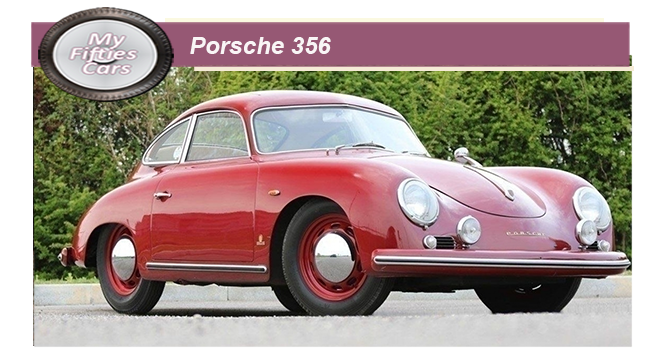 Ferdinand Porsche, the man behind the Volkswagen Beetle, is generally credited with designing the Porsche 356, although most of the design concept was the work of Ferdinand's son Ferdinand Junior, nicknamed " Ferry".
Ferdinand Porsche, the man behind the Volkswagen Beetle, is generally credited with designing the Porsche 356, although most of the design concept was the work of Ferdinand's son Ferdinand Junior, nicknamed " Ferry".
Frederick Snr. and Ferry were given plenty free time to work on their project, arrested by American occupation forces shortly after World War II, and imprisoned in a French Jail.
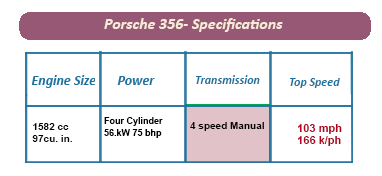 After their release, the Porsche's had already made serious progress with the car's design, firmly based on a rear-engined, air-cooled, rear-wheel-drive car with monocoque construction concept used so successfully on the Beetle.
After their release, the Porsche's had already made serious progress with the car's design, firmly based on a rear-engined, air-cooled, rear-wheel-drive car with monocoque construction concept used so successfully on the Beetle.
The first few Porsche 356s, available in both shallow- windowed Sportster, coupe and cabriolet format were fabricated in Austria initially using aluminium bodywork, although after the Porsches moved back to their native city of Stuttgart the 356's bodies were produced in pressed steel.
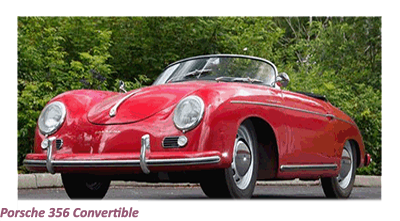 The first aluminium bodied Porsches were produced in Austria up to the beginning of the Fifties.
The first aluminium bodied Porsches were produced in Austria up to the beginning of the Fifties.
These models were much lighter than the metal-bodied versions that began to appear in the first Fifties, requiring just a 1100cc flat-four generating a modest 40bhp. Enough power to allow tremendous performance.
As the pressed steeled version became more commonplace, the Porsches began to realise that the 356 was sorely in need of a more powerful engine to increase its market potential.
Porsche overcame the problem gradually increasing the cubic capacity of the engine till it reached a maximum of 1966 cc by 1959.
 When Porsche's first full production year began in 1950, the 356 was little more than a modified Volkswagen Beetle mechanics beneath what was a handcrafted sports car body.
When Porsche's first full production year began in 1950, the 356 was little more than a modified Volkswagen Beetle mechanics beneath what was a handcrafted sports car body.
However, over the next fifteen years, Porsche continually refined its car, replacing Volkswagen components with in-house designed and wholly improved components that allowed the car to perform and handle better.
![]()
Interestingly, as the 356 became more "Porsche': it also became more expensive, a factor that did not deter the ever-increasing band of discerning drivers who wanted to own a Porsche 356, on both sides of the Atlantic.
By 1955 nearly 8,000 Porsche 356s had been sold.
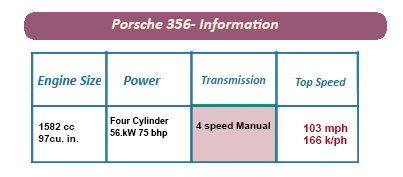 One of the last variants was the desirable Speedster, introduced for American consumption in 1954.
One of the last variants was the desirable Speedster, introduced for American consumption in 1954.
The Speedster was fitted with a dramatically raked windscreen, bucket seats and a skimpy folding top, falling into the 'ride-and-race' category beloved of sporting types who would drive to the meet, remove the windscreen and start racing.
By the late Fifties, Porsche was enjoying a lot of success in the lucrative U.S. market was looking for higher levels of comfort and refinement.
In response, the new Porsche 356B was launched at the 1959 Frankfurt Auto Show, featuring a facelifted front end with improved steering and braking, and a few more creature comforts for its occupants.
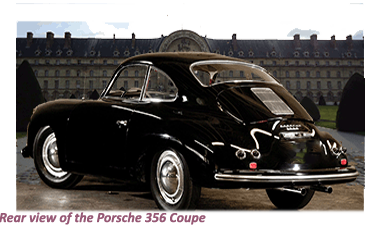 The somewhat rudimentary Speedster was dropped from the lineup in favour of a better trimmed, coach-built cabriolet.
The somewhat rudimentary Speedster was dropped from the lineup in favour of a better trimmed, coach-built cabriolet.
In 1957, horizontal teardrop-shaped tail lamps replaced the earlier quartet of round units, and the license-plate light moved downward, below the plate itself.
 For 1957, vent wings were back (unseen since the very first Porsches), at least on the cabriolet.
For 1957, vent wings were back (unseen since the very first Porsches), at least on the cabriolet.
Coupes got a different version, outside the window frames. Exhaust-pipe tips, which had formerly protruded separately, close to the ground, now exited through the bumper guards.
Up front, a twin-bow over-rider went on the bumper, replacing the former single-bow unit Both open-topped Porsches gained larger back windows.
![]()
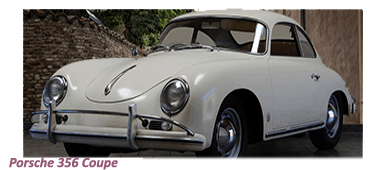 By the mid Fifties, Porsche had come alive to the reality that their customer profile had changed, and looking for more comfort, meaning that the 356 interiors were made more user-friendly.
By the mid Fifties, Porsche had come alive to the reality that their customer profile had changed, and looking for more comfort, meaning that the 356 interiors were made more user-friendly.
 The Carrera version of the 356 was launched in 1955, fitted with an 83kW (112bhp) race-tuned 1498cc (91 cu in) engine, with four overhead camshafts taking it to a top speed of over 120mph.
The Carrera version of the 356 was launched in 1955, fitted with an 83kW (112bhp) race-tuned 1498cc (91 cu in) engine, with four overhead camshafts taking it to a top speed of over 120mph.


